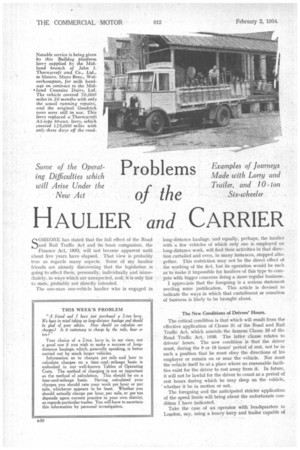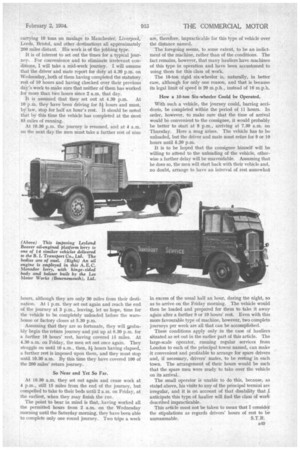Problems of the
Page 62

Page 63

If you've noticed an error in this article please click here to report it so we can fix it.
HAULIER and CARRIER SOMEONE has stated that the full effect of the Road and Rail Traffic Act and its boon companion, the Finance Act, 1933, will not become apparent until about five years have elapsed. That view is probably true as regards many aspects. Some of my haulier friends are already discovering that the legislation is going to affect them, personally, individually and Mimediately, in ways which are Unexpected, and, it is only fair to state, probably not directly intended.
The one-man one-vehicle haulier who is engaged in
long-distance haulage, and equally, perhaps, the haulier with a few vehicles of which only one is employed on long-distance work, will find their activities in that direction curtailed and even, in many instances, stopped altogether. This restriction may not be the direct effect of the working of the Act, but its operation would be such as-to make it impossible for hauliers of this type to cOmpete With bigger concerns doing a more regular business.
I appreciate that the foregoing is a serious statemeitt needing some justification. This article is devised to indicate the ways in which that curtailment or cessation of business is likely to be brought about.
The New Conditions of Drivers' Hours.
The critical condition is that which will result from the effective application of Clause 31 of the Road and Rail Traffic Act, which amends the famous Clause 19 of the• Road Traffic Act, 1930. The latter clause relates to drivers' hours. The new condition is that the driver must, during the 9 or 10 hours' period of rest, not be in such a position that he must obey the directions of his employer or remain on or near the vehicle. Nor must the vehicle itself be at a place where no reasonable facilities exist for the driver to rest away from it. In future, it will not be lawful for the driver to count as a period of rest hours during which he may sleep on the vehicle, "whether it be in motion or not.
The foregoing and the anticipated stricter application of the speed limits will bring about the unfortunate condition I have indicated.
Take the case of an operator with headquarters in London, say, using a heavy lorry and trailer capable of carrying 10 tons on haulage to Manchester, Liverpool, Leeds, Bristol, and other destinations all approximately 200 miles distant. His work is of the jobbing type.
It is of interest to set out the times for a typical journey. For convenience and to eliminate irrelevant conditions. I will take a mid-week journey. I will assume that the driver and mate report for duty at 4.30 p.m. on Wednesday, both of them having completed the statutory rest of 10 hours and having checked over their previous day's work to make sure that neither of them has worked for more than two hours since 2 a.m. that day.
It is assumed that they set out at 4.30 p.m. At 10 p.m. they have been driving for Si hours and must, by law, stop for half an hour's rest. It should be noted that by this time the vehicle has completed at the most 85 miles of running.
At 10.30 p.m. the journey is resumed, and at 4 a.m. on the next day the men Must take a hirther rest of nine hours, although they are only 30 miles from their destination. At I p.m. they set out again and reach the end of the journey at 3 p.m., leaving, let us hope, time for the vehicle to be completely unloaded before the warehouse or factory closes at 5.30 p.m.
Assuming that they are so fortunate, they will Rrobably begin the return journey and put up at 6.30 p.m. for a further 10 hours' rest, having covered 15 miles. At 4.30 a.m. on Friday, the men set out once again. They struggle on until 10 a.m., then, Si hours having elapsed, a further rest is imposed upon them, and they must stop until 10.30 a.m. By this time they have covered 100 of the 200 miles' return journey.
So Near and Yet So Far.
At 10.30 a.m. they set out again and cease work at 4 p.m., still 15 miles from the end of the journey, but compelled to take to their beds until 2 a.m. on Friday, at the earliest, when they may finish the run.
The point to bear in mind is that, having worked all the permitted hours from 2 a.m. on the Wednesday morning until the Saturday morning, they have been able to complete only one round journey. Two trips a week are, therefore, impracticable for this type of vehicle over the distance named.
The foregoing seems, to some extent, to be an indictment of the machine, rather than of the conditions. The fact remains, however, that many hauliers have machines of this type in operation and have been accustomed to using them for this class of work.
The 10-ton rigid six-wheeler is, naturally, in better case, although for only one reason, and that is because its legal limit of speed is 20 m.p.h., instead of 16 m.p.h.
How a 10-ton Six-wheeler Could be Operated.
With such a vehicle, the journey could, barring accidents, be completed within the period of 11 hours. In order, however, to make sure that the time of arrival would be convenient to the consignee, it would probably be better to start at 8 p.m., arriving at 7.30 a.m.. on Thursday. Here a snag arises. The vehicle has to be unloaded, but the driver and mate must retire for 9 or 10 hours until 6.30 p.m.
It is to be hoped that the consignee himself will be willing to attend to the unloading of the vehicle, otherwise a further delay will be unavoidable. Assuming that he does so, the men will start back with their vehicle and, no doubt, arrange to have an interval of rest somewhat in excess of the usual half an hour, during the night, so as to arrive on the Friday morning. The vehicle would then be loaded and prepared for them to take it away again after a further 9 or 10 hours' rest. Even with this more favourable type of machine, however, two complete journeys per week are all that can be accomplished.
These conditions apply only in the case of hauliers situated as set out in the earlier part of this article. The large-scale operator, running regular services from London to each of the principal towns named, can make it convenient and profitable to arrange for spare drivers and, if necessary, drivers' mates, to be resting in each town. The arrangement of their hours would be such that the spare men were ready to take over the vehicle on its arrival., The small operator is unable to do this, because, as stated above, his visits to any of the principal termini are irregular, and it is on account of that disability that ,I anticipate this type of haulier will find the class of work described impracticable.
This article must not be taken to mean that I consider the stipulations as regards drivers' hours of rest to be unreasonable. S.T.R.




























































































